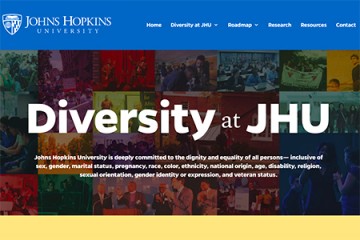Two years after the Roadmap on Diversity and Inclusion laid out a path to strengthen the diversity of Johns Hopkins University's community, the opportunities available on its campuses, and the inclusive climate in which people work and learn, the institution released a report today that details its progress and discusses its ongoing plans.
"Since the launch of the Roadmap, we have made significant progress in key areas, from faculty recruitment and retention to local economic inclusion, but our work is far from complete and our commitments must not be static," JHU President Ronald J. Daniels and Provost Sunil Kumar wrote in an email to students, faculty, and staff today.
The update, they said, "supports the commitment we made when we launched the Roadmap in 2016: to be transparent and accountable as we work toward our ambitious goals."
Recruitment and retention of a diverse faculty continues to be an important aim outlined in the Roadmap, and that effort is supported by the five-year, $25 million Faculty Diversity Initiative. According to the progress report, in 2017–18 the university saw a continued uptick in the hiring of women and underrepresented minority faculty, a group that includes individuals identifying as black or African-American, Hispanic, American Indian, or Hawaiian or other Pacific Islander.
University divisions are continuing to develop and review action plans to support the satisfaction and retention of diverse faculty. They are aided by data from the Collaborative on Academic Careers in Higher Education Faculty Satisfaction Survey, conducted in spring 2018. The university is also focused on enhancing mentorship and career development and expanding its use of exit surveys.
The Roadmap progress report also looks at the recruitment of diverse student classes. Within the undergraduate class entering in fall 2018, 26.4 percent identified as underrepresented minorities, down slightly from 27.2 percent the previous year. The class also included 15.4 percent students eligible for federal Pell grants (even with the previous year); 11.9 percent students who are the first in their families to attend college; and 43 percent female students within the engineering class (up from 40.9 percent the previous year).
The university's commitment to reach and recruit new audiences of students and expand the diversity of admitted classes has been accelerated by a $1.8 billion gift from alumnus Michael R. Bloomberg that will support a permanent commitment to and efforts to recruit a socioeconomically diverse student body.
In addition to examining diversity efforts related to faculty and students, the progress report recounts a number of programs, policies, and divisional efforts aimed at staff, the culture and climate of university campuses, and engaging with Baltimore. Among the highlights, the university has:
- Provided many students with new or lower-cost health care options and expanded family support benefits for employees, doctoral students, post-docs, resident, and interns
- Offered more family-support benefits for employees and expanded the employee assistance program
- Started developing its first report detailing the racial, ethnic, and gender composition of its staff, which will inform a diversity and inclusion strategy for the university's workforce
- Renewed, with Johns Hopkins Health System, its commitment to the HopkinsLocal economic inclusion initiative, which guides efforts to hire more employees from Baltimore City and support local minority- and women-owned businesses
- Developed a new insitutionwide statement on diversity, equity, and inclusion, and updated existing policies into a new discrimination and harassment policy, both of which will be finalized this year
"Each Roadmap progress update allows us to engage in measurement, reflecting upon how we are progressing as well as identifying areas for growth," says Fenimore Fisher, the university's vice provost and chief diversity officer. "This annual report is an important opportunity to assess our overall strategy as well as exhibit transparency by sharing a wealth of data and information. We want our community to continue to hold us accountable and hopefully acknowledge and contribute to our progress."
Individuals are invited to share comments and ideas on diversity and inclusion issues by emailing diversity@jhu.edu.
Posted in University News
Tagged diversity











